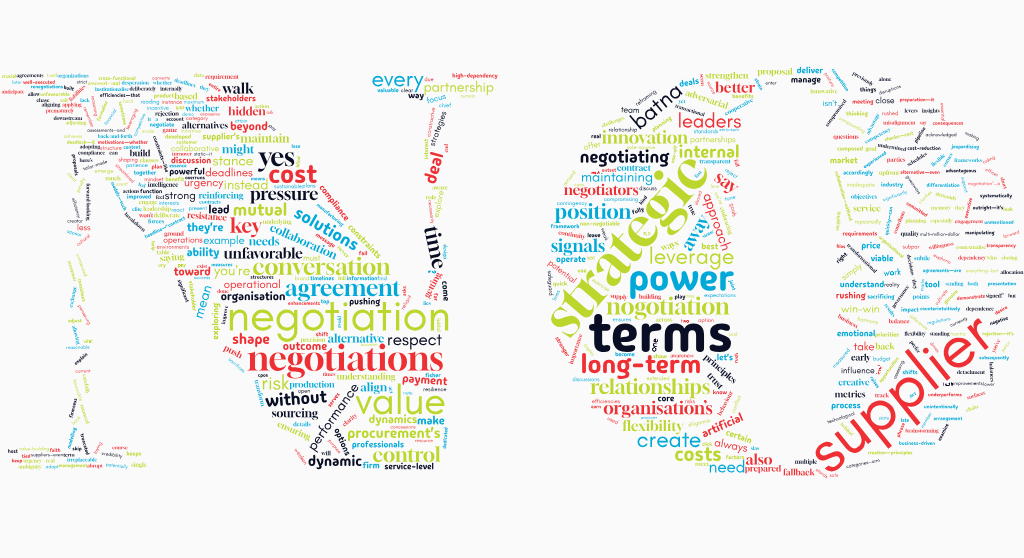Negotiation is a core competency in strategic procurement, but it is also one that evolves with time, technology, and market dynamics.
For Procurement, the evolution from traditional bargaining to a nuanced, value-driven approach marks the difference between routine cost savings and transformational impact.
The mantra of “win-win” negotiations has dominated procurement thinking for decades. While collaborative supplier relationships remain vital, an excessive focus on mutual agreement can undermine your negotiating power and leave value on the table.
Welcome to “Nogotiation” – a framework that balances partnership with strategic resistance.
Firstly, since we will be using the term BATNA in this article, let’s define it upfront:
BATNA stands for Best Alternative To a Negotiated Agreement. It represents the most advantageous course of action a negotiating party can take if negotiations fail and an agreement cannot be reached. It serves as a fallback option or Plan B that negotiators can resort to if the current negotiations do not yield a satisfactory outcome. A strong BATNA ensures that the organisation is not reliant on a single supplier and can walk away from unfavorable terms without jeopardising operations. The concept of BATNA was introduced by Roger Fisher and William Ury in their 1981 book “Getting to Yes: Negotiating Agreement Without Giving In”.
While “Getting to Yes” rightly emphasises the importance of a strong BATNA, its true power lies in your willingness to exercise it—a readiness to say “no” when terms fall short.
This is where “Nogotiation” comes into play: leveraging your fallback options not just to find common ground, but also to shape the power dynamic that underpins every supplier relationship.
Understanding the Power Dynamic
In procurement we often emphasise partnership and mutual value creation—principles that are central to building long-term supplier relationships. Yet even in the most cooperative environments, power dynamics inevitably come into play.
From a procurement lens, your leverage depends on a host of factors: market competition, switching costs, technological differentiation, and your organisation’s ability (or inability) to walk away.
While the desire for “win-win” can facilitate trust, it can also signal dependency if not managed carefully.
Strategic procurement leaders know that negotiations are rarely about what’s said outright—it’s often the subtle signals that shape the outcome.
While the goal may be collaboration, the reality is that every supplier is assessing your position, searching for leverage points, and adjusting their approach accordingly. How you present your needs, how much urgency you display, and even how you phrase your questions can all influence the terms you walk away with.
If you want to control the power dynamic, you need to be aware of the signals you’re sending—both intentionally and unintentionally.
1. Subtle Signals of Urgency
Suppliers are incredibly skilled at reading between the lines, and urgency—real or perceived—is one of the biggest giveaways. Take enthusiasm, for example. It’s natural to show interest during a product demo or supplier presentation, but if your team seems overly eager, it could send the message that you need this supplier more than they need you. A supplier sensing that kind of reliance may become less flexible on price, contract terms, or delivery timelines.
Deadlines create another risk. When procurement professionals repeatedly emphasize tight timeframes, suppliers take note. If they sense desperation—whether from internal pressure or project deadlines—they may adjust their stance accordingly, making fewer concessions and pushing for more favourable terms.
The reality is that urgency, when visible, can weaken your negotiating position. The key is to manage it deliberately—internally aligning on deadlines while externally maintaining a composed and strategic posture.
2. Reading Between the Lines
It’s not just what you say—it’s how you say it. Procurement professionals often default to a cooperative tone, emphasizing long-term partnerships and mutual benefit.
While collaboration is an essential part of supplier relationships, leaning too heavily into “win-win” language can create unintended consequences. If suppliers get the impression that you’re committed to reaching an agreement at all costs, they may push you further, testing your limits on price, contract flexibility, and risk allocation.
Beyond words, suppliers also pay close attention to non-verbal cues. Experienced negotiators pick up on tone, hesitation, and even the number of stakeholders present in discussions. If a supplier detects internal misalignment—say, a junior team member deferring repeatedly to leadership on key decisions—they may exploit this, nudging the conversation toward terms that benefit them rather than you. Procurement leaders need to recognize that they’re constantly being assessed—and that awareness alone can help them manage negotiations with greater precision.
3. Strategic Reframing
Power in negotiations is never static—it fluctuates based on perceived dependence, available alternatives, and the ability to walk away.
This is where BATNA and “Negotiation” principles come together. A strong BATNA isn’t just a theoretical backup—it’s a real source of leverage, reinforcing your ability to say no to unfavorable terms. The more viable options you have, the less reliant you appear, and the stronger your position becomes.
Strategic procurement leaders also understand the importance of managing perceptions. This doesn’t mean hiding key information or being adversarial, but rather maintaining a deliberate balance between openness and control.
For example, discussing big-picture goals and potential long-term collaboration can keep a negotiation constructive, but revealing specific internal constraints—like a lack of alternative suppliers or executive pressure to close quickly—can weaken your stance.
At its core, strategic reframing is about shaping the conversation on your terms, ensuring that while collaboration remains a priority, control over the negotiation never slips away.
The best procurement professionals know how to influence perception, control urgency, and manage information flow—not by manipulating, but by remaining strategic, composed, and fully aware of how their actions shape supplier behaviour.
Power dynamics exist in every negotiation, whether acknowledged or not.
By understanding these dynamics, you don’t just react to supplier tactics—you shape the negotiation before it even begins.
The Hidden Cost of Rushing to “Yes”
Procurement teams are often under intense pressure to deliver quick wins—whether to meet stakeholder expectations, hit quarterly targets, or lock in pricing before budgets expire. On the surface, a fast agreement might feel like a win. It keeps internal teams happy, gets contracts signed, and allows everyone to move forward.
But speed comes at a cost. Rushing toward “yes” without proper diligence can create long-term risks that ripple through the entire organization. What seems like a smooth deal today can turn into an operational bottleneck, a financial liability, or even a reputational issue down the track. Let’s break down the biggest dangers of an overzealous “yes” and why Procurement leaders need to hold their ground when the pressure to close fast mounts.
1. Compromised Due Diligence
There’s an undeniable rush of satisfaction when a deal is closed. But that sense of relief can create tunnel vision, where important details get overlooked. Teams eager to push agreements through might skim over performance clauses, service-level agreements (SLAs), or penalty provisions—only to find out later that there’s no recourse when a supplier underperforms.
And then there’s the issue of risk blind spots. Procurement’s role isn’t just about cost savings—it’s about risk mitigation, and that requires asking tough questions. If quality control measures, regulatory compliance, or supplier financial stability aren’t scrutinized in the rush to sign, Procurement may find itself scrambling to fix problems after the contract is in place. That means emergency sourcing efforts, renegotiations, and damage control—all of which cost far more than a thorough evaluation upfront.
2. Erosion of Long-Term Value
Saying “yes” too quickly doesn’t just create short-term risks—it also limits long-term value creation. When Procurement accepts the first viable offer just to keep things moving, it misses opportunities to push for better payment terms, supplier investment, or innovation partnerships.
Consider this: When a supplier knows a deal is being rushed, what’s their incentive to propose creative solutions? If they aren’t challenged to deliver more than the baseline requirements, they won’t. Fast-tracked negotiations stifle supplier-led innovation, meaning Procurement may unknowingly walk away from a deal that could have reduced costs, improved efficiency, or delivered additional value-added services.
The best Procurement leaders understand that value isn’t just about price—it’s about shaping supplier relationships so that they contribute to long-term strategic goals. And that only happens when there’s enough time to explore those possibilities.
3. Brand & Operational Risks
A rushed deal isn’t just a procurement problem—it’s an operational and reputational risk. Take, for example, a global Chief Procurement Officer who quickly finalized a multi-million-dollar MRO contract. The goal? Locking in cost savings and moving swiftly to execution. But in the process, key performance metrics were overlooked, leaving Procurement powerless when service levels plummeted. The impact? Production delays, operational disruptions, and unhappy internal stakeholders.
It’s not just about efficiency—it’s about reputation. Poor supplier performance can tarnish a company’s brand equity, especially when late deliveries or subpar quality affect the end customer experience. And when Procurement is seen as the department that let those risks slip through? Trust erodes—both externally and internally.
4. Strategic Credibility at Stake
For Chief Procurement Officers, every deal is a reflection of leadership. A rushed agreement that later underperforms signals a lapse in governance, raising concerns about Procurement’s ability to protect the organization’s interests. It’s not just about cost overruns—it’s about whether Procurement is truly acting as a strategic function or merely processing transactions.
The fallout can be financial and cultural. Beyond budget blowouts and legal costs, these missteps can strain cross-functional relationships. When stakeholders lose faith in Procurement’s ability to challenge suppliers and drive value, they start bypassing the function altogether—treating it as a rubber-stamp approval process rather than a trusted business partner.
Rushing to “yes” might deliver a quick headline—“Contract Signed!”—but the unexamined details can lead to a long tail of liabilities.
Saying “yes” might deliver short-term relief, but it often creates long-term liabilities. Procurement leaders need to resist the pressure to rush agreements and instead build the discipline to challenge, verify, and validate every negotiation outcome.
The strongest Procurement teams aren’t the ones that close deals fastest—they’re the ones that balance agility with rigor, push for better outcomes, and ultimately safeguard their organization’s long-term success.
Ready to Elevate Your Negotiations?
→ Discuss Strategic Negotiations with Milan Panchmatia: Explore tailor-made strategies for your organisation’s most complex sourcing challenges.
→ Train Your Team to Become Masterclass Negotiators: Click here for details on our expert-led workshops designed to transform your procurement function with “Nogotiation” principles.
Rushing to “yes” can feel like a quick win but often creates hidden risks and undermines Procurement’s long-term strategic goals. Recognising the power dynamics at play and the dangers of compromise sets the stage for a more deliberate, value-focused approach.
In Part 2, we’ll explore how the strategic use of “no” can reshape supplier relationships, drive innovation, and elevate Procurement’s influence within the organisation. Stay tuned.








